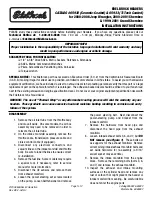
Supplemental Restraint System
A sophisticated electronic system
that continually monitors the
sensors, control unit, airbag
activators, and all related wiring
when the ignition is ON (II).
An indicator light on the instru-
ment panel to alert you to a possi-
ble problem with the system.
Emergency backup power in case
your car's electrical system is
disconnected in a crash.
What Happens In a Crash
If you ever have a severe frontal
collision, the sensors will detect
rapid deceleration and signal the
control unit to instantly inflate the
airbags.
During a crash, your seat belt will
help to restrain your lower body and
torso. The airbags will provide a
cushion to absorb crash energy and
help keep the head and chest of the
driver and front passenger from
striking the interior of the car.
After inflating, the airbags will
immediately deflate. The entire
process, from detection to deflation,
takes a fraction of a second. This
process occurs so quickly that you
may not hear the loud noise created
by the airbag inflators, or realize
what has happened.
After the crash, you may see what
looks like smoke. This is actually
powder from the airbag's surface.
People with respiratory problems
may experience some temporary
discomfort from the chemicals used
by the airbag's activators.
Driver and Passenger Safety















































